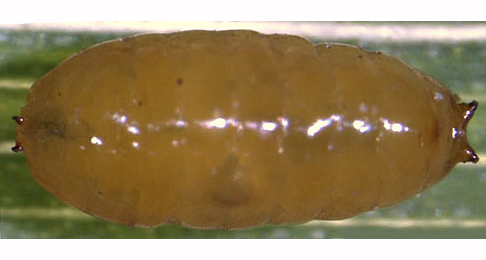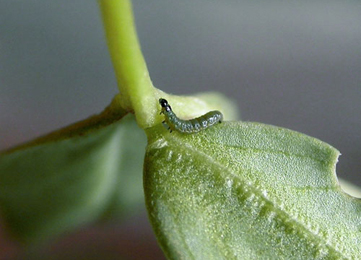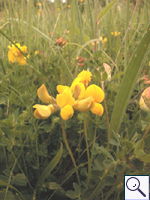|
||||||
|
LOTUS. Bird's-foot-trefoils. [Fabaceae] |
|
|
Fourteen species of Lotus are recorded in Britain. These include the native Slender Bird's-foot-trefoil (L. angustissimus), Hairy Bird's-foot-trefoil (L. subbiflorus), Common Bird's-foot-trefoil (L. corniculatus), Narrow-leaved Bird's-foot-trefoil (L. glaber) and Greater Bird's-foot-trefoil (L. pedunculatus (= L. uliginosus). Nine British miners are recorded miners on Lotus. A key to the European miners recorded on Lotus is provided in Bladmineerders van Europa. The agromyzid Melanagromyza cunctans forms galls in the stems of Lotus in Britain and elsewhere.
|
|
Key for the identification of the known mines of British |
Note: Diptera larvae may live in a corridor mine, a corridor-blotch mine, or a blotch mine, but never in a case, a rolled or folded leaf, a tentiform mine or sandwiched between two more or less circular leaf sections in later instars. Pupation never in a cocoon. All mining Diptera larvae are leg-less maggots without a head capsule (see examples). They never have thoracic or abdominal legs. They do not have chewing mouthparts, although they do have a characteristic cephalo-pharyngeal skeleton (see examples), usually visible internally through the body wall. The larvae lie on their sides within the mine and use their pick-like mouthparts to feed on plant tissue. In some corridor miners frass may lie in two rows on alternate sides of the mine. In order to vacate the mine the fully grown larva cuts an exit slit, which is usually semi-circular (see Liriomyza huidobrensis video). The pupa is formed within the hardened last larval skin or puparium and as a result sheaths enclosing head appendages, wings and legs are not visible externally (see examples). See Key to non-Diptera. |
1a > Leaf-miner: Larva producing a short narrow linear mine not associated with the margin, which then develops into a conspicuous white blotch centred on the mid-rib. At the end of feeding the larva lies for one or two days along the mid-rib. Pupation external (Spencer, 1972b: 37 (fig. 114b); Spencer, 1976: 126, fig. 213A). Broad and short hook-like upper-surface corridor, ending in a little blotch in the centre of a leaflet. The blotch is upper-surface as well, but has some deep spots, giving the mine a mottled appearance when hold against the light. Frass in the blotch in a few large lumps. Pupation outside the mine. A short, broad gallery leading to a conspicuous, roundish white blotch in the centre of the leaf. The blotch is upper surface with full depth spots - comprising of large clumps of frass. Puparium reddish |
|
Agromyza nana Meigen, 1830 [Diptera: Agromyzidae]. |
1b > Leaf-miner: An upper surface linear mine with frass in conspicuous greenish strips, largely alternating at each side of the channel. Puparium yellow |
 Liriomyza congesta puparium Image: © Willem Ellis (Bladmineerders van Europa) |
|
Liriomyza congesta (Becker, 1903) [Diptera: Agromyzidae]. |
|
Key for the identification of the known mines of British |
Note: The larvae of mining Coleoptera, Hymenoptera and Lepidoptera may live in a corridor mine, a corridor-blotch mine, a blotch mine, a case, a rolled or folded leaf, a tentiform mine or sandwiched between two more or less circular leaf sections in later instars. Larva may pupate in a silk cocoon. The larva may have six legs (although they may be reduced or absent), a head capsule and chewing mouthparts with opposable mandibles (see video of a gracillarid larva feeding). Larvae of Hymenoptera and Lepidoptera usually also have abdominal legs (see examples). Frass, if present, never in two rows. Unless feeding externally from within a case the larva usually vacates the mine by chewing an exit hole. Pupa with visible head appendages, wings and legs which lie in sheaths (see examples). |
1a > Leaf-miner and case-bearer: The larva lives outside the mine, protected by a case, and feeds on the underlying plant tissues via a hole cut in the epidermis. From that point it eats away as much leaf tissue as it can reach without fully entering the mine. Mine does not contain frass (Coleophora species) |
1b > Leaf-miner, but not a case-bearer: The larva lives mainly inside the mine. Mine usually contains frass. In later instars the larva may live sandwiched between two more or less circular sections cut from the leaf. |
2 > Leaf-miner and case-bearer: The initial mine is like that of a nepticulid. The case is made form excised leaf portions, which are added to the oral end, leading to the ringed appearance. The larva causes the leaf to have white blotches. Identification cannot be made on these alone as similar blotches can be made by early instar larvae of the Common Blue butterfly (Polyommatus icarus). Oviposition at the leaf underside, mostly in a vein axil. The larva begins by making a narrow winding corridor with much frass in a broad central line. The corridor reminds that of a nepticulid (but the egg has a finely reticulate surface, unlike the smooth nepticulid egg.) In the end the corridor widens into an oval blotch, usually close to the leaf margin, out of which the first case is made. The full grown larva in a greyish brown composite leaf case of about 6 mm, attached to the underside of a leaf. The oldest quarter of the case is bivalved, laterally compressed, and is at an angle of 70° with the anterior part of the case. The mouth angle is around 40°. |
|
Coleophora discordella Zeller, 1849 [Lepidoptera: Coleophoridae]. |
3a > Leaf-miner: The first generation initially forms an unmistakable leaf-mine on Anthyllis vulneraria, but the second generation feeds on the flowers. Feeding signs on other plants vary in appearance. Larvae can move between sewn leaves, and more than one larva may be found together. Larvae in a small full depth blotch, often with extensions. Frass concentrated in one corner of the mine. The mining activities may cause the leaf to roll inwards. Older larvae live free among spun leaves, but still they may make then full depth mines by feeding on the leaf tissue from a small opening. |
 Aproaerema anthyllidella larva, dorsal Image: © Steve Wullaert (Bladmineerders van Europa) |
|
Aproaerema anthyllidella (Hübner, 1813) [Lepidoptera: Gelechiidae]. |
3b > Leaf-miner: In the first instar the larva mines the leaves, forming short, irregular, blotch-like mines, but in later instars it lives externally, feeding in spun leaves and often twisting those of tender shoots. Larval head light-brown or yellowish brown, edged with black postero-laterally, ocellar area blackish; prothoracic plate black edged with whitish anteriorly; abdomen dull dark green; pinacula distinct, black, sometimes brownish but with black bases to setae; anal plate large, black (Bradley et al., 1973). Small, full depth mine without a definite shape; little frass. Some silk is deposited in the mine. The larva soon leaves the mine and continues feeding among spun leaves. |
|
Cnephasia incertana (Treitschke, 1835) [Lepidoptera: Tortricidae]. |
3c > Leaf-miner: The frass is arranged in a spiral and a circular blotch is formed. Egg at the underside of the leaf. The mine is an upper-surface blotch without anything like a preceding corridor. The blotch is about circular, but my have broad lobes. Black frass grains lie in indistinct arcs or spirals, glued to the upper epidermis, and forming a cark central patch. The larva can leave a mined leaf, and restart elsewhere. Pupation external. Cocoon spun beneath the leaf. |
|
Leucoptera lotella (Stainton, 1859) [Lepidoptera: Lyonetiidae]. |
3d > Leaf-miner: The mine is underside, occupying the whole leaflet, which turns down at edges. Lower surface tentiform mine that occupies an entire leaflet; lower epidermis strongly folded. Fully developed mines are strongly inflated and the leaflet is so completely folded over the mine that the latter becomes practically invisible. In this stage the larva has consumed also all tissue in the roof of the mine, making the mine very conspicuous. |
|
Phyllonorycter nigrescentella (Logan, 1851) [Lepidoptera: Gracillariidae]. |
3e > Leaf-miner: An initial gallery, which usually follows the leaf margin. Then forms a blotch, mining from the leaf base to the tip. The presence of a pupa in the mine is unusual for this species and may indicate parasitism. Oviposition on the leaf underside. The mine begins as a long corridor with a very broad, green frass line. This corridor suddenly widens into a broad blotch, that in the end may occupy almost an entire leaflet. The blotch generally begins in the leaf base, and it is here that most frass is concentrated. Shortly before pupation the larva leaves its mine through an exit slit in the lower epidermis. After the mine has been vacated the leaflet drops off. |
|
Trifurcula cryptella (Stainton, 1856) [Lepidoptera: Nepticulidae]. |
3f > Leaf-miner: Egg at the upperside or underside of the leaf. The mine begins as a long narrow corridor with a linear frass line. The corridor abruptly widens into a blotch that in the end may occupy almost an entire leaflet. The blotch mostly starts at the base of the leaflet, and here also most frass is concentrated. Pupation generally within the mine; in rare cases the larva leaves the mine by an exit slit in the lower epidermis. |
|
Trifurcula eurema (Tutt, 1899) [Lepidoptera: Nepticulidae]. |
| Last updated 05-Jul-2019 Brian Pitkin | ||

